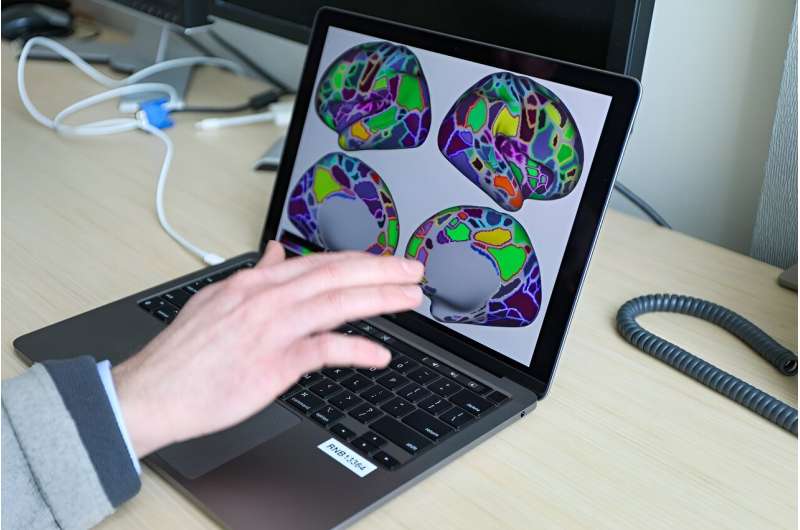This article has been reviewed according to Science X's editorial process and policies. Editors have highlighted the following attributes while ensuring the content's credibility:
fact-checked
peer-reviewed publication
trusted source
proofread
Using neuroimaging, researchers confirm cumulative, brain-wide effects of ADHD

Researchers at Oregon Health & Science University and the University of Minnesota Masonic Institute for the Developing Brain leveraged a large national dataset and neuroimaging to confirm the brain-wide effects of attention-deficit hyperactivity disorder, or ADHD.
The study, published in the Journal of Neuroscience
, further unravels the complex relationship between
"Our group at OHSU is very interested in identifying risk factors for ADHD so that we can improve assessment for kids who may be living with this disorder," said Michael A. Mooney, Ph.D., assistant professor of medical informatics and clinical epidemiology in the OHSU School of Medicine, faculty in OHSU's Center for Mental Health Innovation and the study's corresponding author.
"By evaluating the cumulative effects of regions across the entire brain, we are now looking at ADHD as a whole-brain issue, which could make it easier to predict which kids have ADHD and how severe it may be," Mooney continued. "Down the road, we hope this will help with early identification of kids at most risk, so they can get the help they need as soon as possible."
ADHD is a common neurodevelopmental disorder affecting approximately 3.5% of people in the U.S., and is characterized by cognitive, behavioral and emotional differences. In children, this can lead to trouble paying attention and controlling impulsive behaviors, which may cause difficulty in school, at home and with peers.
Currently, there is no single, universal test to predict or diagnose children with ADHD; typically, a medical provider will make a diagnosis based on a physical exam, medical history and evaluation of a child's symptoms.
Previous studies often looked at whether children with ADHD show differences in specific networks or areas in the brain, however, this study aimed to challenge that method. In the study, researchers were able to confirm via analysis of neuroimaging data that there are cumulative, brain-wide effects of ADHD, which calls for a whole-brain approach to ADHD research, diagnosis and treatment.
Brain-wide signal
The study leveraged the Adolescent Brain Cognitive Development Study, or ABCD, dataset—a groundbreaking study of nearly 12,000 children, ages 9 and 10, that is mapping behavioral, social and brain development over a 10-year period.
With this dataset, researchers used neuroimaging data to construct a polyneuro risk score, or PNRS, a method that calculates the likelihood of a health outcome based on a patient's brain activity—or more specifically, brain connectivity, which is the correlation of activity between multiple different regions of the brain.
The PNRS method consists of two steps. First, one data set is used to identify a brain-wide pattern of connectivity that is associated with a particular trait; in this case, ADHD symptoms. Then, a second dataset is used to validate whether that connectivity pattern truly predicts the trait. Participants with brain activity very similar to the pattern identified earlier are given a higher score, while those less similar are given a lower score.
Association between the PNRS and ADHD symptoms was tested in a subset of the ABCD study group, and then further tested in the independent Oregon-ADHD-1000 case-control study group. In both groups, the findings suggested a robust association between brain-wide connectivity and ADHD symptoms.
"This is exciting, because much of the prior research has focused on individual regions of the brain, but our study was seeing that this isn't the case across the board," Mooney said. "In fact, there is signal from all areas of the brain that are contributing to the risk of ADHD."
Looking forward, researchers will investigate whether these findings are consistent among different ages and points in time across the child's lifespan. Additionally, researchers are interested in the application of the PNRS method to predict risk for other neurological disorders, such as depression or anxiety.
"At this stage of research, we're still evaluating the clinical utility of these findings. However, it certainly points toward not looking at behavioral conditions in a silo," Mooney said.
"Our hope is to continue research into this area so that in the future, we can improve the method to a point that it could actually be used in health care settings, providing ADHD risk prediction and assessment."
More information: Michael A. Mooney et al, Cumulative Effects of Resting-state Connectivity Across All Brain Networks Significantly Correlate with ADHD Symptoms, The Journal of Neuroscience (2024). DOI: 10.1523/JNEUROSCI.1202-23.2023




















